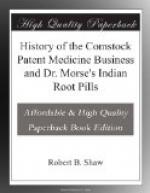So it seems almost certain that Edwin was no longer a novice when he established his own drug business in New York City. Between 1833 and 1837 he employed his brother, Lucius S. Comstock (born in 1806), as a clerk, and for the next fifteen years Lucius will figure very conspicuously in this story. He not merely appended the designation “M.D.” to his name and claimed membership in the Medical Society of the City of New York, but also described himself as a Counsellor-at-Law.
Edwin, the founder of the business, did not live long to enjoy its prosperity—or perhaps we should say that he was fortunate enough to pass away before it experienced its most severe vicissitudes and trials. After Edwin’s death in 1837, Lucius continued the business in partnership with another brother, Albert Lee, under the style of Comstock & Co. Two more brothers, John Carlton (born 1819) and George Wells (born 1820), were employed as clerks.
[Footnote 1: National Cyclopedia of American Biography, VII: 280.]
[Footnote 2: The Comstock brothers’ grandmother, Esther Lee, was apparently unrelated to Dr. Samuel Lee, the inventor of the Bilious Pills.]
[Illustration: Figure 1.—Original wrapper for Carltons Liniment, 1851.]
The partnership of Comstock & Co. between Lucius and Albert was terminated by a dispute between the two brothers in 1841, and Albert went his own way, taking up a career as a physician and living until 1876. Lucius next went into business with his mother-in-law, Anne Moore, from 1841 to 1846; after the dissolution of this firm, he formed a new partnership, also under the name of Comstock & Co., with his brother John (generally known as J. Carlton). This firm again employed as clerks George Wells Comstock and a nephew, William Henry, a son of Edwin. William Henry was to eventually become the founder of the business at Morristown.
In March of 1849, still a new partnership was formed, comprising Lucius, J. Carlton, and George Wells, under the name of Comstock & Co. Brothers, although the existing partnership of Comstock & Co. was not formally terminated. Assets, inventories, and receivables in the process of collection were assigned by Comstock & Co. to Comstock & Co. Brothers. But before the end of 1849 the partners quarreled, Lucius fell out with his brothers, and after a period of dissension, the firm of Comstock & Co. Brothers was dissolved as of August 1, 1850. On or about the same date J. Carlton and George Wells formed a new partnership, under the name of Comstock & Brother, doing business at 9 John Street in New York City, also taking their nephew, William Henry, as a clerk. Lucius continued in business at the old address of 57 John Street. As early as June 30, 1851, the new firm of Comstock & Brother registered the following trade names[3] with the Smithsonian Institution: Carlton’s Liniment, a certain remedy for the Piles; Carlton’s Celebrated Nerve and Bone Liniment for Horses; Carlton’s Condition Powder for Horses and Cattle; Judson’s Chemical Extract of Cherry and Lungwort.




